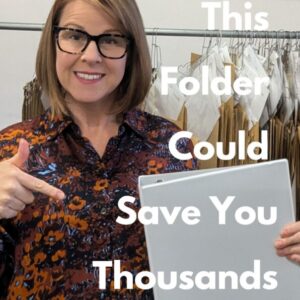Designer Cost-Saving Secret: The Organizational Folder

Ever wonder how you can save money and stay organized as a designer? It’s simpler than you think. Let’s dive into the concept of an organizational folder and how it can be your secret weapon for cost-saving development.
Start a Folder Each Season
Each design season brings new challenges. By starting a folder dedicated to each season’s product range, you centralize all important documents. This folder should hold design briefs, finished specifications, fabric details, markers, and label information. Having everything in one place reduces the risk of losing important information, saving you time and money. This practice is a vital part of cost-saving development.
Imagine this: instead of searching through piles of papers or endless email threads, you have everything you need in one handy folder. It saves time, reduces stress, and helps you stay on top of your game. Staying organized this way is a game-changer for cost-saving development.
Track Your Fabric and Labels
Fabric and labels can be major expenses for designers. Many people stress over small price differences but often end up with unused materials gathering dust. By keeping detailed records of how much fabric and how many labels you buy and use, you can prevent unnecessary purchases. This means knowing exactly what you have left after each production run, so you don’t reorder materials you already have. Keeping track of your supplies is essential for cost-saving development.
For instance, have you ever bought extra labels because you weren’t sure if you had enough? By keeping meticulous records, you avoid this issue entirely. Accurate record-keeping is a cornerstone of cost-saving development.
Click the image below to watch this week video
Avoid Double Spending
One key to cost-saving development is knowing exactly where your money goes. Keeping all records in one folder prevents double spending. When you plan your second production run, immediate access to your previous orders and stock levels helps you avoid unnecessary costs, ensuring you only buy what you need. This will stop you from second-guessing and make your process more fluid.
Think about it: how often have you bought more fabric or trims simply because you couldn’t remember what you had? By keeping an organized folder, you avoid these costly mistakes. This method is an effective way to achieve cost-saving development.
Simplify Communication
Sorting through numerous emails to find specific information can be a nightmare. An organized folder simplifies this process, as everything you need is in one place. Before starting any run, having all your documents well-organized means you can communicate clearly with your manufacturers, preventing mistakes and delays that often-cost money. Simplified communication is a key aspect of cost-saving development.
Imagine the ease of pulling out your folder during a meeting and having all the information at your fingertips. This not only saves time but also reduces the chance of errors, leading to smoother operations and cost-saving development.
Maintain Your Budget and Timeline
Your folder isn’t just about materials. Place your project timeline on the front cover and include budget tracking sheets inside. This keeps you aware of your progress and spending, ensuring you stay within budget. This practice not only saves money but also keeps your project on schedule. Budget and timeline management are crucial elements of cost-saving development.
By tracking your expenses and timeline meticulously, you ensure that no part of your project goes over budget or past deadlines. This disciplined approach is integral to successful cost-saving development.
Conclusion
Keeping an organizational folder might seem tedious, but it can save you thousands of dollars. It simplifies your workflow, keeps your budget on track, and ensures you know exactly what you have and need. Start this habit today and watch how it transforms your design process. Remember, good record-keeping is a sign of a smart business person and is essential for cost-saving development.
By following these tips, you can master cost-saving development and make your design business more efficient and profitable.
Have you downloaded the 7 Myths of offshore v onshore Manufacturing yet?
Are you looking at local manufacturing, but it just seems a bit too hard. Get your FREE Guide: The 7 Myths of Getting Your Fashion Label Made Locally.
This guide will help you understand why your journey to get your product made has been made more difficult.
This Guide is for you if…
- You have been calling manufacturers, but no one seems to be calling you back.
- You have a great idea-but you don’t know what to do next
- You have tried overseas but it seemed like a waste of time, and you want an easier way to communicate to get the right samples
- You are feeling overwhelmed by the process of starting your label and all the work involved
- You had a tech pack made but need help with the rest of the process
- You have knowledge on how to start a business but as to how to make the clothes, you are lost’
- You are confused about where to even begin
- You tried overseas but communication and timing is so hard and they are struggling to get things right
LINK: https://sample-room.mykajabi.com/7Myths-ebook-syfbw
